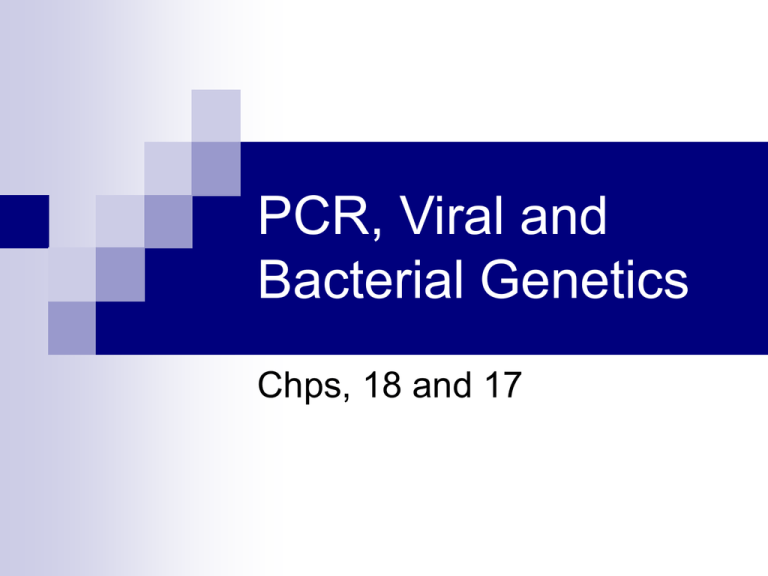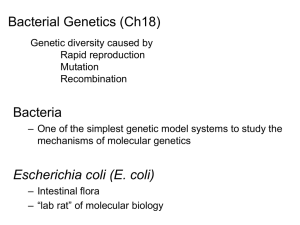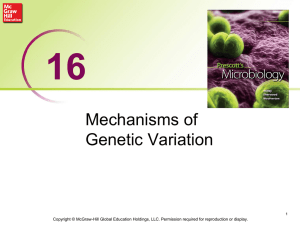
PCR, Viral and
Bacterial Genetics
Chps, 18 and 17
Learning Objectives
Describe the process of PCR
Explain the use of gel electrophoresis
List the essential components of bacterial DNA
Compare and contrast transduction, transformation and
conjugation as a means of bacterial gene exchange
Describe the process of replica plating
Compare and contrast the lytic and lysogenic cyle of
bacteriophages
Describe transposons in eukaryotes
Polymerase Chain Reaction
Polymerase chain reaction (PCR)
Produces
many sequence copies without host
cloning
Amplifies known DNA sequences for analysis
Only copies sequence of interest
Primers bracket sequence
Agarose gel electrophoresis
Separates
fragments by size and charge
Gel molecular sieve
Cycle 1
Cycle 2
2 molecules produced
Produces 4
molecules
Target
sequence
DNA containing
target sequence
to be amplified
Template
DNA
primers
DNA
primer
DNA
primer
Target
sequence
Target
sequence
Cycle 3
Produces 8
molecules
New
DNA
New
DNA
These 2
molecules
match
target
DNA
sequence
Template
Fig. 18-6, p. 378
Animation: Polymerase chain reaction
(PCR)
Micropipettor
adding marker
DNA fragments
to well
–
–
Well in gel for
placing DNA
sample
Agarose
gel
Buffer
solution
Gel box
+
PCR
products
already
loaded to
wells
+
Fig. 18-7a, p. 380
Lane with
marker DNA
fragments
Fig. 18-7b, p. 380
Bacterial and Viral
Genetics
Chapter 17
Bacterial Genetics
One-celled prokaryotic organisms
Only some are pathogenic (ie, causing
diseases)
Many are symbiotic (ie, E. coli)
Some can be infected by viruses
(bacteriophages)
Bacterial Genetics
Single circular strand of DNA
Bacteria are haploid
Bacteria do not undergo true sexual
reproduction
However, gene exchange and
recombination is important for survival and
adaptation
Bacterial Genetics
Three main ways to get DNA from one
bacteria to another for recombination
Conjugation
Transduction
Transformation
Bacterial Plasmids
Bacteria can recombine DNA with other
bacteria of similar strains (conjugation)
The exchange involves plasmids (small
circular pieces of DNA)
F+ (fertility) bacteria contain plasmids that
allow for transfer
Bacterial Plasmids
To initiate transfer, a bacterium produces a
“conjugation bridge”- a tube extends from
the F+ (donor) bacterium to the F(recipient) bacterium
The donor’s plasmid separates, and a
complimentary piece travels across the
bridge to the recipient bacterium
A complimentary strand is produced by the
recipient
The recipient becomes an F+ bacterium
a. Transfer of the F factor
Bacterial
chromosome
1
An F+ cell conjugates with an F– cell.
F factor
F+
F–
2 One
strand of the F factor breaks at
a specific point and begins to move
from F+ (donor) to F– (recipient) cell
as the F factor replicates.
DNA replication of the F factor continues
in the donor cell, and a complementary
strand to the strand entering the recipient
cell begin to be synthesized.
3
4 When
transfer of the F factor is complete,
replication has produced a copy of the F
factor in both the donor and recipient cells;
the recipient has become an F+. No
chromosomal DNA is transferred in this
mating.
Fig. 17-4a, p. 356
Bacterial Plasmids
Sometimes bacterial plasmids (the F factor) can
integrate into the bacterial chromosome
This bacterium is called Hfr (high frequency
recombination)
This bacterium can conjugate with recipient
cells, allowing part of the bacterial DNA to enter
the recipient cell
The recipient cell is now partially diploid and
double crossover rearrangement can occur
Bacterial Plasmids
b. Transfer of bacterial genes
c+ b+
d+ a+
Bacterial
chromosome
1 The F+ cell.
F factor
c+ b+
d+ a +
2 F factor integrates into the E. coli
chromosome in a single crossover event.
c–
d–
a–
–
b
3 A cell with integrated F factor—an Hfr
donor cell —and an F– cell conjugate. These
two cells differ in alleles: the Hfr is a+ b+ c+
d+, and F– cell is a– b– c– d–.
c+ b+
d+ a+
Hfr cell
Bacterial
chromosome
F– cell
Fig. 17-4b (1), p. 356
Bacterial Plasmids: closer look
Mapping Genes by
Recombination
Full DNA transfer by conjugation takes 90
to 100 minutes
Partial
DNA transfer when sex pilus breaks
Timing of DNA transfer allows mapping of E.
coli chromosome, map units are minutes
Order and timing of DNA transfer show E.
Coli has circular chromosome
Bacterial Plasmids
Kinds of information carried on plasmids
includes:
Resistance
to antibiotics (R)
Ability to manufacture amino acids
Fertility factor (F+) - proteins for the
conjugation bridge
Bacterial Transformation
Some bacteria have DNA-binding proteins
on their cell walls
They can integrate similar bacterial DNA
into their own genome
This can be natural or induced in the lab
by heat or electroporation (electrical
shock)
Bacterial Transduction
DNA may also be carried by
bacteriophages
When a bacteriophage is being assembled
in an infected cell, it may incorporate
pieces of the bacterial DNA into its shell
That DNA is injected along with
bacteriophage DNA during the next
infection cycle
Bacteriophages
Virulent- always kill their hosts after replication.
Temperate- can live inside host for generations,
DNA being replicated in a controlled fashion until
activated
Lytic cycle- virus proteins cause viral assembly
(both viral and cell DNA) and cell bursts
Lysogenic cycle- quiescent bacterial replication
with viral DNA integrated into bacterial
chromosome
Replica Plating
Replica plating identifies and counts
genetic recombinations in bacterial
colonies
Master
plate pressed onto sterile velveteen
Velveteen pressed onto replica plates with
different growth media
Complete medium has full complement of
nutrient substances
Auxotrophic
mutants will not grow on media
missing particular nutrients
Master plate with
complete medium
Replica plate with
minimal medium
Colony growth
Fig. 17-5a, p. 359
Bacteriophages
T even phages
Lambda (λ) – temperate phage which
reactivates easily with UV light
Lambda phage is used
E. coli Lambda Bacteriophage
Lamba (λ) E. coli bacteriophage
Typical temperate phage with two paths
Lytic cycle goes directly from infection to progeny virus
release
Lysogenic cycle integrates λ chromosome into host
Insertion at specific sequences, then crosses over
Prophage viral genome inactive until trigger
Specialized transduction transfer of host genes near λ
genome
Lytic Cycle
Lysogenic Cycle
Stepped Art
Fig. 17-8, p. 362
17.3 Transposable Elements
Insertion sequence elements and
transposons major types of bacterial
transposable elements
Transposable elements were first
discovered in eukaryotes
Eukaryotic transposable elements are
classified as transposons or
retrotransposons
Transposons and TEs
Transposable genetic elements (TE) or
jumping genes
Two major types of bacterial TEs:
insertion sequences – inverted repeat
sequence and coding for transposase
Transposons- inverted repeat and central
genes, including host genes- most notably
antibiotic resistance
Transposable Elements
Transposable elements (TEs)
Segments of DNA that move around cell genome
Transposition is movement of TEs, jumping gene
Target site of TE is not homologous with TE
No crossing over
TEs can move in two ways
Cut-and-paste, original TE leaves
Copy-and-paste, original TE stays in place
Why is it important
Proteins for recombination, excision and
insertion, replication and packaging
provide a “molecular toolkit” for genetic
engineering








